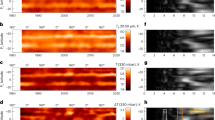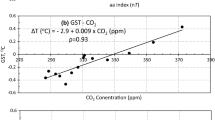Abstract
The possible relationship between the 60-year variation in global temperature with an amplitude of 0.35°C and the corresponding cycle at the location of Jupiter and Saturn is considered. It was shown that the gravitational perturbation of the Earth’s orbit by Jupiter and Saturn can only account for a global temperature variation of only 0.012°C. It is shown that the modulation of the flux of cosmic dust entering the Earth’s atmosphere by the gravitational field of Jupiter and Saturn is a more promising mechanism for the transmission of the influence of giant planets on the Earth’s climate. In order for the global temperature to experience variation with an amplitude of 0.3°C, Jupiter and Saturn must provide a variation in the flux of extraterrestrial matter in the Earth’s atmosphere with an amplitude of 16%. The question of whether these two planets are capable of providing such a variation is of considerable interest for climatology.

Similar content being viewed by others
REFERENCES
Dohnanyi, J.S., Interplanetary objects in review: statistics of their masses and dynamics, Icarus, 1972, vol. 17, pp. 1–48.
Ermakov, V.I., Okhlopkov, V.P., and Stozhkov, Yu.I., Influence of cosmic rays and cosmic dust on the atmosphere and earth’s climate, Bull. Russ. Acad. Sci.: Phys., 2009, vol. 73, pp. 416–418.
Feingold, G., Eberhard, W.L., Veron, D.E., and Previdi, M., First measurements of the Twomey indirect effect using ground-based remote sensors, Geophys. Res. Lett., 2003, vol. 30, no. 6, pp. 1287–1299. https://doi.org/10.1029/2002GL016633
Froyd, K.D., Murphy, D.M., Sanford, T.J., et al., Aerosol composition of the tropical upper troposphere, Atmos. Chem. Phys., 2009, vol. 9, pp. 4363–4385.
Granitsky, L.V. and Borisevich, A.N., Research of influence of the meteoric stream on the weather condition: Preliminary consideration, Proc. SPIE, 2000, vol. 4341, pp. 563–570.
Hunten, D.M., Turco, R.P., and Toon, O.B., Smoke and dust particles of meteoric origin in the mesosphere and stratosphere, J. Atmos. Sci., 1980, vol. 37, pp. 1342–1357.
IPCC, Summary for Policymakers. Climate Change 2013: The Physical Science Basis. Contribution of Working Group I to the Fifth Assessment Report of the Intergovernmental Panel on Climate Change, Stocker, T.F., Qin, D., Plattner, G.-K., et al., Eds., Cambridge: Cambridge Univ. Press, 2013.
Ivanov, V.V., Periodic weather and climate variations, Phys.-Usp., 2002, vol. 45, no. 7, pp. 719–752.
Kane, T.J. and Gardner, C.S., Lidar observations of the meteoric deposition of mesospheric metals, Science, 1993, vol. 259, pp. 1297–1300.
Kasatkina, E.A., Shumilov, O.I., and Lukina, N.V., Stardust component in tree rings, Dendrochronologia, 2007, vol. 24, pp. 131–135.
Lal, D. and Jull, A.J.T., Atmospheric cosmic dust fluxes in the size range 10–4 to 10 centimeters, Astrophys. J., 2002, vol. 576, pp. 1090–1097.
Landgraf, M., Kruger, H., Altobelli, N., and Grün, E., Penetration of the heliosphere by the interstellar dust stream during solar maximum, J. Geophys. Res., 2003, vol. 108, no. A10, pp. 8030–8043. doi 10.10292003JA009872
Love, S.G. and Brownlee, D.E., A direct measurement of the terrestrial mass accretion rate of cosmic dust, Science, 1993, vol. 262, pp. 550–553.
Marsh, N. and Svensmark, H., Cosmic rays, clouds and climate, Space Sci. Rev., 2000, vol. 94, nos. 1–2, pp. 215–230.
Mathews, J.D., Janches, D., Meise, D.D., and Zhou, Q.-H., The micrometeoroid mass flux into the upper atmosphere: Arecibo results and a comparison with prior estimates, Geophys. Res. Lett., 2001, vol. 28, pp. 1929–1932.
Maurette, M., Jehanno, C., Robin, E., and Hammer, C.U., Characteristics and mass distribution of extraterrestrial dust from the Greenland ice cap, Nature, 1987, vol. 328, pp. 699–702.
Murphy, D.M., Extraterrestrial material and stratospheric aerosols, in Accretion of Extraterrestrial Matter Throughout Earth’s History, Boston: Springer, 2001, Peucker-Ehrenbrink, B. and Schmitz, B., Eds., pp. 129–142.
Napier, W.M. Temporal variation of the zodiacal dust cloud, Month. Not. Roy. Astr. Soc., 2001, vol. 321, pp. 463–470.
Nesvorný, D.P., Jenniskens, H.F., Levison, W.F., et al., Cometary origin of the zodiacal cloud and carbonaceous micrometeorites: Implications for hot debris disks, Astrophys. J., 2010, vol. 713, no. 2, pp. 816–836.
Ogurtsov, M.G. and Raspopov, O.M., Possible impact of interplanetary and interstellar dust fluxes on the Earth’s climate, Geomagn. Aeron. (Engl. Transl.), 2011, vol. 51, no. 2, pp. 275–283.
Plane, J.M.C., Cosmic dust in the Earth’s atmosphere, Chem. Soc. Rev., 2012, vol. 41, pp. 6507–6518.
Rapp, M. and Thomas, G.E., Modeling the microphysics of mesospheric ice particles: Assessment of current capabilities and basic sensitivities, J. Atmos. Sol.-Terr. Phys., 2006, vol. 68, pp. 715–744.
Rapp, M., Strelnikova, I., and Gumbel, J., Meteoric smoke particles: Evidence from rocket and radar techniques, Adv. Space Res., 2007, vol. 40, pp. 809–817.
Rasmussen, K.L., Clausen, H.B., and Kallemeyn, G.W., No iridium anomaly after the 1908 Tunguska impact: Evidence from a Greenland ice core, Meteoritics, 1995, vol. 30, pp. 634–638.
Rosinski, J. and Snow, R.H., Secondary particulate matter from meteor vapors, J. Meteorol., 1961, vol. 18, pp. 736–745.
Scafetta, N., Empirical evidence for a celestial origin of the climate oscillations and its implications, J. Atmos. Sol.-Terr. Phys., 2010, vol. 72, pp. 951–970.
Scafetta, N., Testing an astronomically based decadal-scale empirical harmonic climate model versus the IPCC (2007) general circulation climate models, J. Atmos. Sol.-Terr. Phys., 2012, vol. 80, pp. 124–137.
Sitarski, G., Secular acceleration in the motion of the periodic comet Wolf–Harrington, Acta Astron., 1970, vol. 20, pp. 271–279.
Sykes, M.V., Grün, E., Reach, W.T., and Jenniskens, P., The interplanetary dust complex and comets, in Comets II, Festou, M., Keller, U., and Weaver, H., Eds., Tuscon: Univ. of Arizona Press, 2004, pp. 677–693.
Voigt, C., Schlager, H., Luo, B.P., et al., Nitric acid trihydrate (NAT) formation at low NAT supersaturation in polar stratospheric clouds (PSCs), Atmos. Chem. Phys., 2005, vol. 5, pp. 1371–1380.
Yakovlev, B.A., Atmospheric precipitation in relation to meteoric flows and comets, Izv. Vses. Geogr. O-va, 1991, no. 5, pp. 419–424.
Yiou, F., Raisbeck, G.M., and Jehanno, C., The micrometeorite flux to the Earth during the last 200 000 years as deduced from cosmic spherule concentration in Antarctic ice cores, Meteoritics, 1991, vol. 24, no. 4, pp. 412–426.
Zecca, A. and Chiari, L., Comets and climate, J. Atmos. Sol.-Terr. Phys., 2009, vol. 71, nos. 17–18, pp. 1766–1770.
Funding
The work was supported by the Russian Foundation for Basic Research, projects nos. 18-02-00583, 19-02-00088.
Author information
Authors and Affiliations
Corresponding author
Rights and permissions
About this article
Cite this article
Ogurtsov, M.G. Possible Contribution of the Gravitational Influence of Jupiter and Saturn to the 60-Year Variation in Global Temperature. Geomagn. Aeron. 60, 391–395 (2020). https://doi.org/10.1134/S0016793220030135
Received:
Revised:
Accepted:
Published:
Issue Date:
DOI: https://doi.org/10.1134/S0016793220030135




